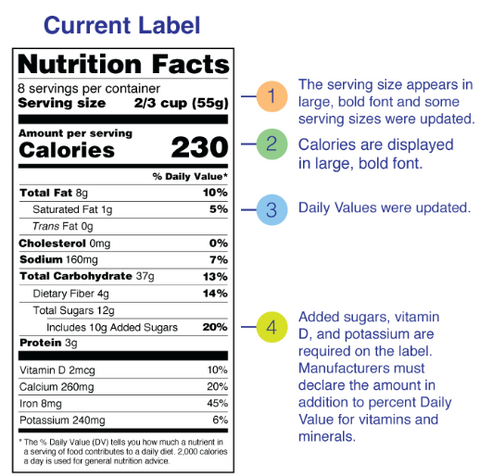Understanding nutrition labels for food is key to making better-informed decisions about the foods you choose. But sometimes that can be easier said than done. According to past research, many consumers have difficulty interpreting nutrition labels, which is problematic because research also shows that reading labels leads to making healthier food choices.1,2
The confusion is not surprising considering that over the years, nutrition label style and information have had several iterations with the last update taking place in 2021.3
Get The Facts
According to the US Food and Drug Administration (FDA), “The label’s refreshed design and updated information make it easier for you to make informed food choices that contribute to lifelong healthy eating habits.”
The current label helps consumers identify pertinent information including serving size, calories, daily nutrient values, and ingredients. In addition, added sugars, vitamin D, and potassium are required on the label, and food manufacturers must declare the amount in addition to the percentage of the daily values for vitamins and minerals.

The Importance of Label Checking
Key areas to focus on first when reading a label are the serving size, servings per container, and calories per serving. For example, if a bottle of sweetened tea has a serving size of eight ounces and there are 70 calories per serving and there are two servings per container, if you drink the whole bottle of sweet tea, you’ve consumed 140 calories.
Total carbohydrates are also important because, in that section of the label, the information about total sugars and added sugars is included. For that same bottle of sweetened tea, there are 18 grams of total added sugars. Why is that so important? The Dietary Guidelines for Americans recommends less than 50 grams of sugar a day so with that one bottle of sweetened tea, you’ve consumed more than 30% of the recommended amount for the entire day.
The ingredients section of the label is also very important. In that section, ingredients are listed from highest amount to lowest amount. Pay close attention to the first several ingredients listed. Choose foods that list whole foods or healthy ingredients in that beginning ingredient section and try to avoid foods that contain unfamiliar, hard-to-pronounce, or chemical-sounding ingredients. Also, if the ingredient list is long, that’s a good sign that the product is highly processed and should probably be avoided.
National Nutrition Month
March is National Nutrition Month which gives you the perfect opportunity to focus on fine-tuning your label-reading skills. Check labels carefully. Compare nutrition facts and compare food products to make the healthiest choices possible.
The FDA provides even more resources here to help you create healthy eating habits.
For more tips on nutrition, mindful wellness practices, and helping your family feel their best, follow us on Facebook @kalvits and Instagram at @kalvitamins!
References
- Persoskie A, Hennessy E, Nelson WL. US consumers’ understanding of nutrition labels in 2013: the importance of health literacy. Preventing Chronic Disease. 2017;14. https://www.cdc.gov/pcd/issues/2017/17_0066.htm
- Mhurchu C, Eyles H, Jiang Y, Blakely T. Do nutrition labels influence healthier food choices? Analysis of label viewing behavior and subsequent food purchases in a labelling intervention trial. Appetite. 2018;121(1):360-365. https://www.sciencedirect.com/science/article/pii/S0195666317309923
- US Food & Drug Administration. Changes to the nutrition facts label. 2023;Dec 7. https://www.fda.gov/food/food-labeling-nutrition/changes-nutrition-facts-label




